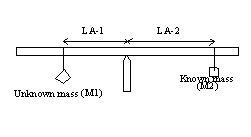
Name:_______________________________Date:_______________Time:____________
Partner(s):_____________________ Course:_________________
________________________________________________________________________
Uniform Circular Motion
Purpose: To determine the centripetal force required to keep a known mass at a uniform circular motion.
Apparatus: Centripetal force apparatus, stop clock, meter stick, knife-edge stand, knife-edge clamp, mass-set, and mass-hanger.
Theory: a. Circular Motion
In this experiment a body of mass, m, is made to rotate in a circular motion. The speed of the revolving body will be (or should be) kept constant. Even then there is acceleration because the velocity changes direction continuously. The acceleration is called centripetal (or center seeking) and is given by:
ac = v2 / R ; where v is the linear speed of the revolving body and R is the radius of the circle of revolution.
Using Newton's second law the centripetal force can be written as:
Fc = m v2 / R ; where m is the mass of the revolving body.
The linear speed v can be measured using the following equation:
v = 2B
R/T; where T is the period of revolution.As the axis in the apparatus is rotated uniformly, the body of mass m, revolves with a radius R. The period T can be obtained by timing a certain number of revolutions. The centripetal force can be calculated by using the equation: Fc = m v2 / R. In addition one can directly measure the centripetal force by hanging a weight (Fs = msg) that will produce an equivalent elongation on the spring. Fc and Fs should agree within a reasonable experimental error.
b. Measuring the mass of the revolving body, unknown mass, M1:
This mass is too heavy for the electronic balance. A beam-balance method will be used to measure its mass. Meter stick is supported at the center of gravity.

Unknown mass will try to rotate the meter stick counter
clockwise and known mass will try to rotate the meter stick clockwise.
Counter clockwise torque = Unknown mass X Lever-Arm-1
Clockwise torque = Known mass X Lever-Arm-2
For balance, counter clockwise torque must equals the clockwise torque.
Unknown mass X Lever-Arm-1 = Known mass X Lever-Arm-2
Unknown mass = [Known mass X Lever-Arm-2] ÷ [Lever-Arm-1]
Procedure:
1) Clamp the meter stick in the support clamp at its center of gravity. Hang the unknown mass near one end of the stick. Hang a 400 gm mass near the other end of the stick and obtain the balance. Record the positions of the masses. Determine the Lever-Arm-1 and Lever-Arm-2 and finally the mass of the revolving body.
2) Level the apparatus with the adjusting screws provided for that purpose. The apparatus is level when the crossbar will stay in any arbitrary position.
3) Set the radius indicator for minimum radius, then set the crossbar so that the body (mass m), with spring unattached, hangs directly above the radius indicator. Measure and record this radius in the data table.
4) Now attach the spring to the body and determine the static force necessary to return the body to a position directly above the radius indicator. Record the mass, ms, in the data table.
5) Disconnect the hanging mass from the rotatable mass and practice rotating the crossbar by hand, using the finger grip provided, until you are proficient at maintaining a frequency of rotation that will keep the rotating mass at the radius of the indicator.
6) Measure the time required for a definite number rotations (at least 50) of the crossbar.
7) Repeat procedures 3 - 6 for other values of R, ending with the maximum possible value.
DATA
A. Mass of the revolving body, m.
Draw a diagram of the balanced meter-stick in the box below and record the positions for center of gravity, unknown mass, and known mass.
Known-mass = ________________
Lever-Arm-1 = _________________
Lever-Arm-2 = _________________
Unknown-mass = m = ____________
Use SI units: Mass of the revolving body from above, m = ___________
|
R |
ms |
# of revolutions |
total time |
|
- |
- |
- |
- |
|
- |
- |
- |
- |
|
- |
- |
- |
- |
|
- |
- |
- |
- |
|
- |
- |
- |
- |
|
- |
- |
- |
- |
|
- |
- |
- |
- |
8) Enter the above data in a spread sheet program and calculate the following:
T, v, ac
, Fc, Fs , and % difference between Fc and Fs.9) Plot Fs Vs ac and determine the mass (m) of the rotating body from the graph.
mass of the rotating body = m = _____________
10) Compare the mass from procedure (9) with that from procedure (1).
11) Observe your data and explain why the total time decreased as the radius increased?
12) Compare and contrast the above circular motion with that of the planets around the Sun and explain your findings.
13) Visit the Circular Motion web site.
14) Change the radius and observe what happens.
15) Compare and contrast the above circular motion with that of the planets around the Sun and explain your findings.